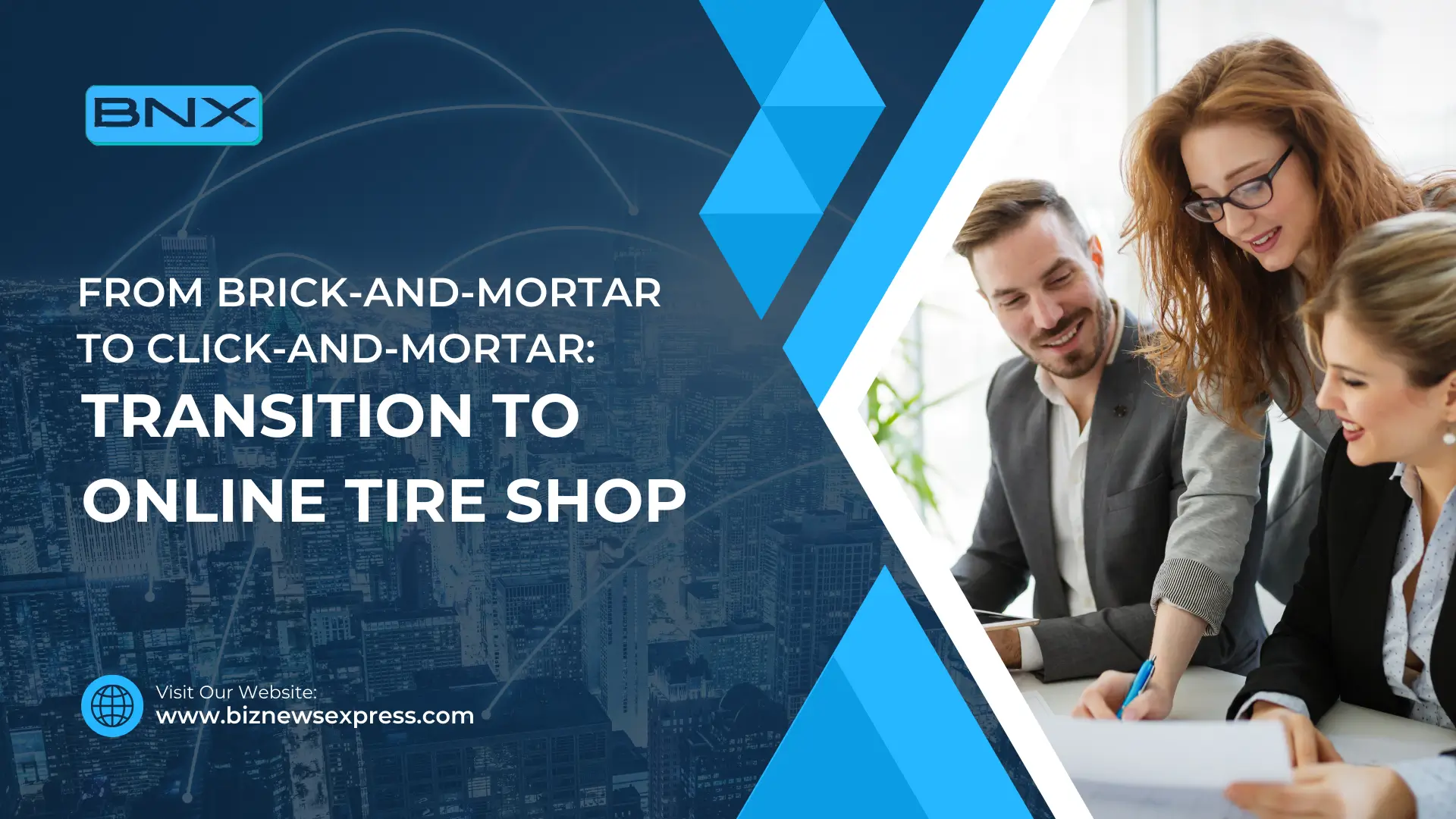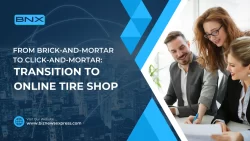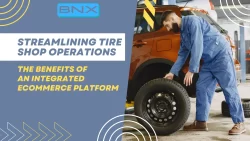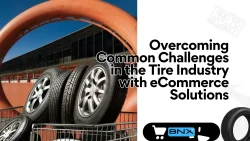From Brick-and-Mortar to Click-and-Mortar: Transition to Online Tire Shop

In the current digital era, the retail industry is always changing. Customers are increasingly using online platforms for their shopping needs, whether they are for groceries or electronics. Tire shops and other traditional brick-and-mortar establishments must adapt to this environment to remain competitive and relevant. Making a transition to online tire shop from a physical shop is not merely a fad; it’s a calculated decision that will help your company survive and adapt to the shifting needs of your clientele.
Challenges of Running a Traditional Brick-and-mortar Tire Shop
- Restricted Geographical Reach
Physical stores are only able to draw clients from the neighborhood, which limits the size and expansion prospects of the possible market.
- High Overhead
The costs of operating a physical storefront, such as rent, utilities, insurance, and staffing, can be a burden on profits.
- Inventory management
It can be difficult to manage and store a large variety of tire sizes and brands without a lot of room and effective organization.
- Competition
Local and large chain stores pose a serious threat to brick-and-mortar tire stores, which frequently results in price wars and lower profit margins.
- Convenience for Customers
In recent times, consumers are choosing internet shopping more and more because it offers convenience that physical stores can’t match.
- Restricted Operating Hours
Online stores are available around the clock, giving physical stores an advantage over traditional retailers, which have set operating hours.
- Marketing and Visibility
Investing heavily in local advertising and promotions is necessary to draw in customers, but these efforts may not always provide the expected return on investment.
- Technology Integration
Traditional tire businesses may find it difficult and expensive to keep up with technological improvements and incorporate them into their business model.
- Customer Expectations
In an entirely offline context, it can be challenging to meet the modern customer’s expectations for seamless service and rapid access to information.
What is Step-by-Step Process to Transition to Online Tire Shop?
Making the switch from a physical tire store to an online eCommerce platform needs significant thought and preparation. The following procedure will walk you through the process of digitally transformation of tire business:
- Market Research
To fully grasp your target market’s tastes and online purchasing behaviors, start with a thorough investigation of the market. Determine the main rivals and examine their web presence and tactics.
- Selecting the Proper eCommerce Platform
Choose a strong eCommerce platform that complements your company’s objectives and requirements. Consider elements like inventory management tools, payment methods, customization possibilities, and ease of use.
- Product Catalog Optimization
Create an extensive product catalog that effectively displays your tire inventory. To improve the browsing experience for customers, include filter options, thorough descriptions, and high-quality photographs.
- Website Design and Development
To build a visually beautiful and user-friendly online storefront, invest in professional website design and development. For a frictionless buying experience, make sure that the checkout process is simple, mobile responsive, and smooth.
- Integrate Online and Offline Operations
Set up procedures tointegrating online sales with physical stores, sync with the inventory and appointment booking of your physical business. Efficiency and consumer satisfaction are increased by this connection, which guarantees correctness and consistency across all channels.
- Marketing and Promotion
To increase traffic to your online tire store, create a strong digital marketing plan. To connect and interact with your target audience, make use of channels like social media, email marketing, search engine optimization (SEO), and pay-per-click (PPC) advertising.
- Customer Service and Support
To foster loyalty and trust among online shoppers, offer first-rate customer service and support. To improve the general customer experience, provide a variety of avenues for communication, quick answers to questions, and simple return procedures.
- Analytics and Optimization
Use analytics tools to keep an eye on important metrics like website traffic, conversion rates, and sales performance. Utilize this information to pinpoint areas in need of development and to maximize the impact of your web presence.
Advantages of Having an Online Presence Alongside a Physical Store
There are several benefits of opting for tire eCommerce development for your company and clients when you combine your online and offline presences:
- Increased Reach
By going online, you can connect with clients who live outside of your neighborhood and reach new markets and demographics. It contributes immensely to boosting sales in tire shops.
- 24/7 Availability
Regardless of the time or place, clients may explore and buy tires from an online storefront whenever it’s convenient for them.
- Enhanced Convenience
Giving clients the opportunity to shop online gives them the freedom to choose, evaluate, and purchase tires from the comfort of their homes.
- Cost Savings
Making the switch to online sales can save overhead expenses like rent, utilities, and staffing that come with running a physical store.
- Enhanced Customer Experience
An integrated online and offline experience enables seamless interactions with customers, from browsing products to scheduling appointments and receiving support.
Real-life Case Studies
1. Tire Rack
When Tire Rack was first established in 1979, it was just one retail location in Indiana. Tire Rack pioneered the online tire sales business in 1996 when it opened its first website, seeing the potential of the Internet.
Path to eCommerce
- Early Adoption: Tire Rack was among the first tire manufacturers to see the possibilities of online shopping. They made an investment in a thorough website with a large selection, reviews, and in-depth tire information.
- Customer Education: The business made a point of providing clients with a wealth of internet information, such as reviews, videos, and tire tests. This strategy increased confidence and aided clients in making wise choices.
- Technology Integration: To improve user experience and conversion rates, Tire Rack built sophisticated search tools and algorithms to match clients with the best tires for their vehicles.
Outcomes
- Market Leader: Tire Rack has led the online tire retail sector thanks to its early adoption and ongoing innovation.
- Extended Reach: Tire Rack’s internet platform facilitated nationwide customer service, surpassing the constraints of their brick-and-mortar store.
- Increased Sales: Customers were much more satisfied, and sales were greatly increased by the ease of online buying and thorough product information.
2. Discount Tire Direct
Founded in 1960, it is one of the largest independent tire and wheel retailers in the U.S. In the late 1990s, the company launched Discount Tire Direct to tap into the growing eCommerce market.
Journey to eCommerce
- Strategic Planning: Discount Tire carefully planned its entry into eCommerce, ensuring that its online presence complemented its extensive network of physical stores.
- Customer-Centric Approach: The company focused on providing excellent customer service online, mirroring the high standards of their brick-and-mortar locations. This included live chat support, easy returns, and comprehensive FAQs.
- Logistics and Distribution: Discount Tire invested in robust logistics and distribution networks to ensure fast and reliable delivery of online orders.
Outcomes
- Increased Market Share: The online platform helped Discount Tire capture a significant share of the online tire market, reaching customers who preferred shopping from home.
- Brand Strength: By maintaining high service standards online, Discount Tire strengthened its brand reputation and customer loyalty.
- Sales Growth: The integration of online and offline sales channels contributed to substantial growth in overall sales.
In Summary
Moving your tire store from a physical location to an online one presents both a strategic necessity and a chance for expansion and creativity. In the always-changing retail industry, you may broaden your customer base, boost revenue, and maintain a competitive edge by adopting a digital transformation of tire business. You can make the move and succeed in the online economy with careful preparation, execution, and a customer-centric mindset.






